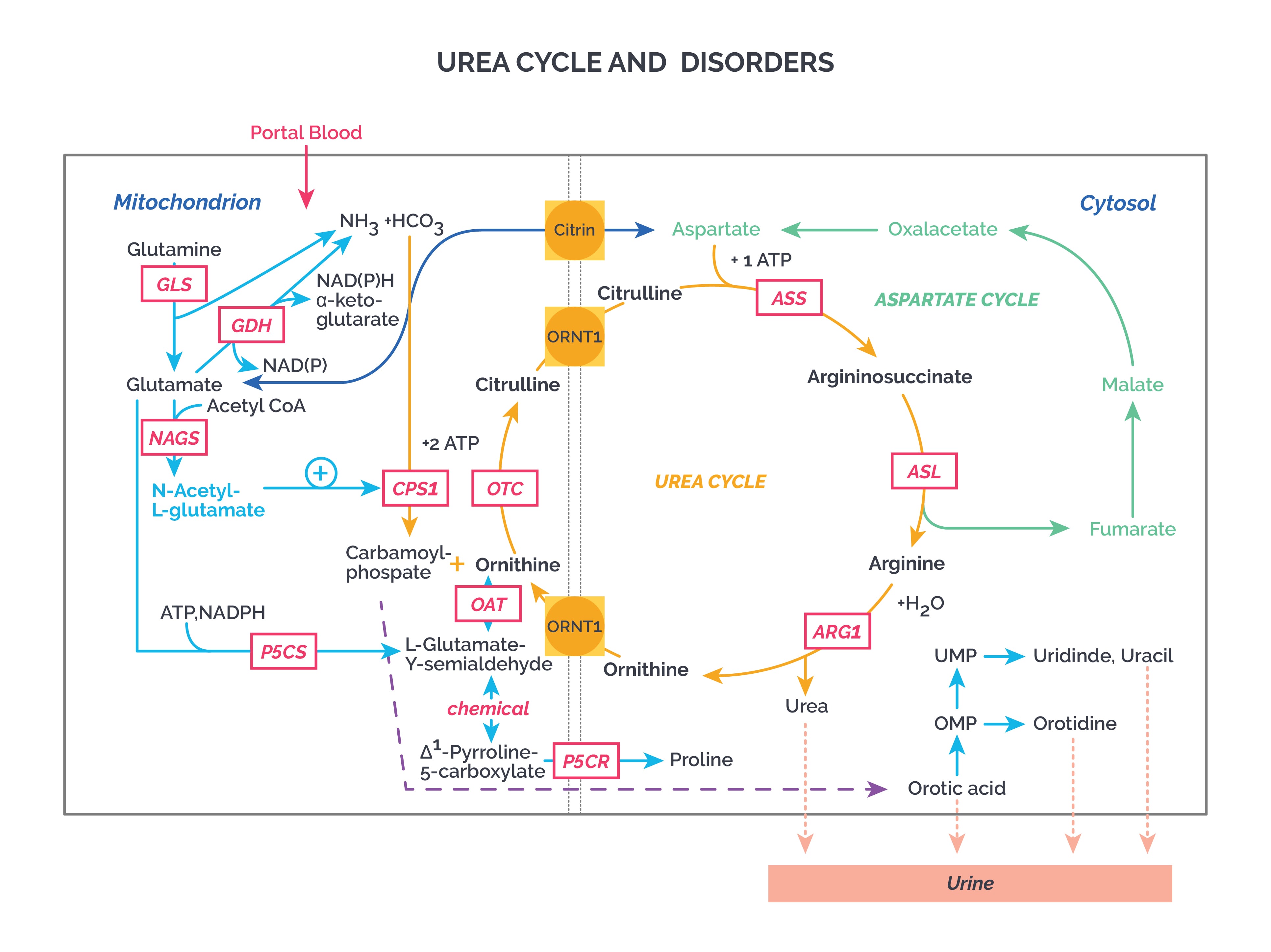The urea cycle disorders (UCD) result from genetic mutations causing defects in the metabolism of the extra nitrogen produced by the breakdown of protein and other nitrogen-containing molecules. It results in the accumulation of ammonia and other precursor metabolites during the first few days of life. Infants with a urea cycle disorder often initially appear normal but rapidly develop cerebral edema and related signs. In milder (or partial) urea cycle enzyme deficiencies, ammonia accumulation may be triggered by illness or stress at almost any time of life.
Urea cycle: Carbamoyl phosphate synthetase (CPS) and ornithine transcarbamylase l are present only in the liver and intestines. CPS 1 is the rate limiting enzyme. Valproic acid inhibits urea cycle.
Signs and symptoms of UCDs are as follows:
Normal appearance at birth
Irritability progressing to somnolence, lethargy, then coma
Loss of thermoregulation (hypothermia)
Feeding disruption (increases catabolism)
Neurologic posturing (from cerebral edema)
Seizures, dementia
Hyperventilation and then hypoventilation
Vomiting
Behavior changes
All UCDs are autosomal recessive except OTC deficiency which is X linked. Along with CPSI and NAGS deficiency, OTC deficiency is the most severe of the urea cycle disorders. Following are the UCDs:
N-acetylglutamate Synthase Deficiency (NAGS): NAG is a cofactor for CPS 1. In NAGS, this cofactor cannot be formed. Severe disease. Hyperammonemia.
Carbamoyl Phosphate I Synthase (CPS I) Deficiency: Severe disease. Hyperammonemia.
Ornithine Transcarbamylase (OTC) Deficiency: Severe disease. More common in male patients. Hyperammonemia.
Argininosuccinate Synthase Deficiency (ASSD or Citrullinemia I): Hyperammonemia. Less severe disease. Elevated citrulline levels.
Citrin Deficiency (Citrullinemia II): Citrin is an aspartate glutamate transporter across the mitochondrial membrane. Hyperammonemia, intrahepatic cholestasis, neurological findings, jaundice, fatty liver, elevated citrulline, hyperlipidemia. Japanese or Asian ancestry.
Argininosuccinate Lyase Deficiency (Argininosuccinic Aciduria): Hyperammonemia, hepatomegaly, elevated transaminases, Arginosuccinic acid elevated in blood and urine, cirrhosis, trichorrhexis nodosa or node like fragile hair.
Arginase deficiency (Hyperargininemia): Progressive spasticity of lower limbs, seizures, growth retardation, anorexia, vomitings, irritability, milder hyperammonemia, elevated arginine in blood.
Ornithine Translocase Deficiency (HHH Syndrome): Also known as Hyperornithinemia, Hyperammonemia and Homocitrullinuria syndrome. Orotic acid present in urine. Reduced transport of ornithine into mitochondria. Clinical features like arginase deficiency.

Tip: Remember that NAGS, OTC and CPS I deficiency can also cause elevated orotic acid in urine. Similarly, orotic aciduria caused by UMPS gene defect in pyrimidine biosynthesis pathway presents with megaloblastic anemia plus elevated orotic acid in urine.
Sign up for free to take 1 quiz question on this topic